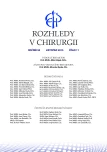Our experience with the measurement of transcutaneous oxygen tension for evaluation of blood circulation in peripheral arteries in patients with critical ischemic disease of lower limbs
Authors:
V. Žižlavský; L. Kubíček; R. Staffa
Authors place of work:
II. chirurgická klinika, Centrum cévních onemocnění, FN u sv. Anny a LF MU Brno
přednosta: prof. MUDr. R. Staffa, Ph. D.
Published in the journal:
Rozhl. Chir., 2015, roč. 94, č. 11, s. 459-463.
Category:
Původní práce
Summary
Introduction:
The measurement of transcutaneous oxygen pressure (TcpO2) is a non-invasive method to quantify skin oxygenation at capillary level and their nutritive ability needed to heal the ischemic defect. TcpO2 pressure values below 30 mm Hg are specific for critical limb ischemia and predict complicated healing. The purpose of this study was to verify the cut-off pressure in patient unable to undergo vascular reconstruction, and to verify the possibility of using this method to evaluate the effectiveness of vascular reconstructive surgery.
Methods:
The group included 52 patients (35 men and 17 women). The mean age of patients in the group was 66.5 years (max. 85, min. 44).
Results:
In our group of patients we confirmed that the TcpO2 values of successfully healed ischemic wounds were equal or greater than 30 mm Hg (mean TcpO2 value at the dorsum of the foot was 37.0 mm Hg ±9.5 mm Hg), compared to the group of unsuccessfully healed patients whose values were lower (mean TcpO2 value at the dorsum of the foot was 9.0 mm Hg ±5.3 mm Hg).
Conclusion:
TcpO2 is a suitable method in predicting the healing of ischemic defects and any possible need for surgical or endovascular revascularization. Thanks to its non-invasive nature and undemanding measurement, it surely helps to make better decisions in choosing the therapeutic procedure needed to heal the defect.
Key words:
transcutaneous oxygen tension − cut-off value − revascularization
Zdroje
1. Bém R, Jirkovská A, Dubský M, et al. Dlouhodobé zkušenosti s transkutánní oxymetrií. Bulletin HPB chirurgie 2008; 4 : 567−72.
2. Schubert V. The influence of local healting on skin microcirculation in pressure ulcers, monitored by a combined laser Doppler and transcutaneous oxygen tension probe. Clinical Physiology 2000;20 : 413–21.
3. Wirth F, Annette Bryder-Jacobsen T. & J. Cataloging Internet Resources: The tcpO2Handbook [on line]. Printed in Denmark by Radiometer Medical ApS, 2700 Brønshøj, 2008. Dostupný na www: ISBN 87-88138-87-9, 989-969.200806C.
4. Takkin Lo, Richard S, Patrick M, et al. Prediction of wound healing outcome using skin perfusion pressure & transcutaneous oximetry. Wounds 2009;21 : 11−3.
5. Arsenault KA, McDonald J, Thorlund K, et. al. The use of transcutaneous oximetry to predict complications of chronic wound healing: a systematic review and meta-analysis. Wound Repair Regen 2011;19 : 657–63.
6. Wutschert R, Bounameaux H. Determination of amputation level in is-chemic limbs. Reappraisal of the measurement of TcPo2. Diabetes Care 1997;20 : 1315−8.
7. Caselli A, Latini V, Lapenna A, et al. Transcutaneous oxygen tension monitoring after successful revasculari-zation in diabetic patients with ischaemic foot ulcers. Diabet Med 2005;22 : 460−5.
8. Fife CE, Buyukcakir C, Otto GH, et al. The predictive value of transcutaneous oxygen tension measurement in diabetic lower extremity ulcers treated with hyperbaric oxygen therapy. Wound Repair Regen 2002;10 : 198–207.
9. Claeys LG, Horsch S. Transcutaneous oxygen pressure as predictive parameter for ulcer healing in endstage vascular patients treated with spinal cord stimulation. Int Angiol 1996;15 : 344–9.
10. Nechis D, Golden M. Cataloging Internet Resources: Treatment of chronic lower extremity critical limb ischemia [on line]. UpToDate, Jun 24, 2014. Dostupný z www: ISBN 978-1-4939-1326-8.
11. Bradbury AW, Adam DJ, Bell J, et al. Bypass versus angioplasty in severe ischaemia of the leg (BASIL) trial: An intention-to-treat analysis of amputation-free and overall survival in patients randomized to a bypass surgery-first or a balloon angioplasty-first revascularization strategy. J Vasc Surg 2010;5 : 5S.
12. Arroyo CI, Tritto VG, Buchbinder D, et al. Optimal waiting period for foot salvage surgery following limb revascularization. J Foot Ankle Surg 2002;41 : 228–32.
13. Wagner HJ, Schmitz R, Alfke H, et al. Influence of percutaneous transluminal angioplasty on transcutaneous oxygen pressure in patients with peripheral arterial occlusive disease. Radiology 2003; 226 : 791–7.
Štítky
Chirurgia všeobecná Ortopédia Urgentná medicínaČlánok vyšiel v časopise
Rozhledy v chirurgii

2015 Číslo 11
- Metamizol jako analgetikum první volby: kdy, pro koho, jak a proč?
- Antidepresivní efekt kombinovaného analgetika tramadolu s paracetamolem
- Fixní kombinace paracetamol/kodein nabízí synergické analgetické účinky
Najčítanejšie v tomto čísle
- Hepatální pseudoléze v blízkosti falciformního ligamenta
- Naše zkušenosti s měřením transkutánní tenze kyslíku pro hodnocení prokrvení periferie dolních končetin u pacientů s chronickou ischemickou chorobou dolních končetin
- Resekabilní karcinom pankreatu − 5leté přežití
- Léčba infekce v třísle po tepenné rekonstrukci pomocí podtlakové terapie
